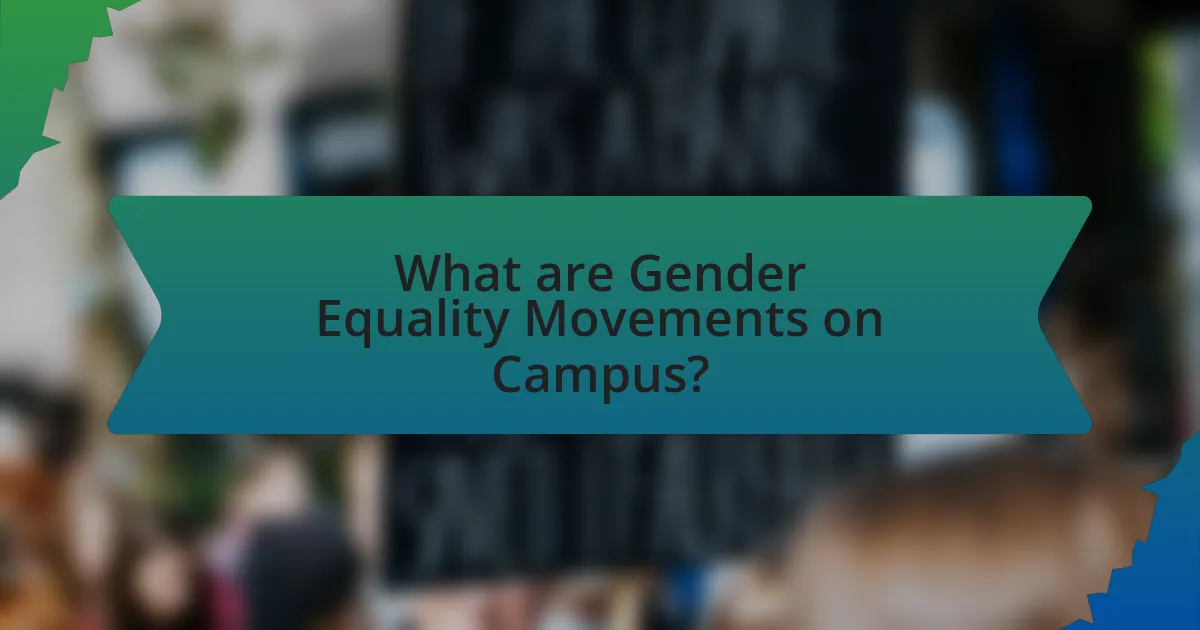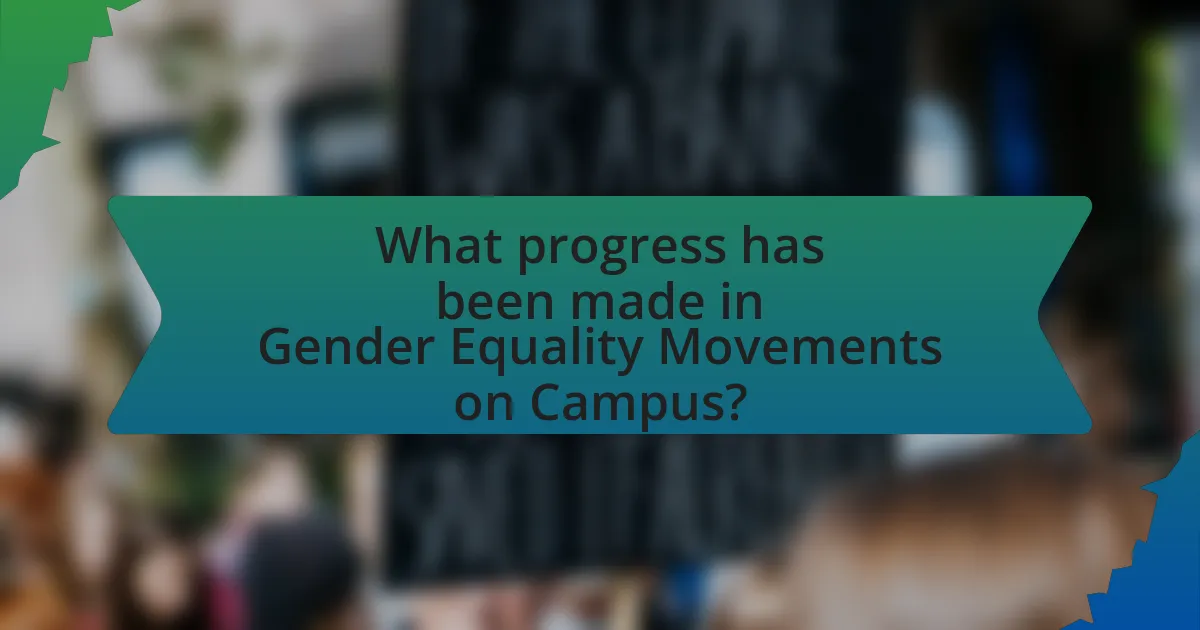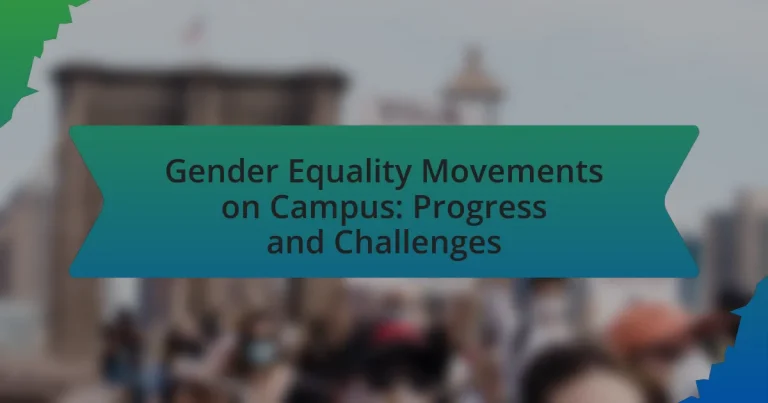Gender equality movements on campus are organized efforts by students and faculty aimed at promoting equal rights and opportunities for all genders within educational institutions. These movements address critical issues such as sexual harassment, pay equity, and representation in leadership roles, with historical roots tracing back to the women’s suffrage movement and evolving through various feminist waves. The article explores the evolution of these movements, the impact of cultural contexts, and the primary goals of promoting inclusivity and eliminating gender-based discrimination. It also highlights the challenges faced, including institutional resistance and intersectional issues, while discussing strategies for advocacy and the importance of student engagement in driving progress.

What are Gender Equality Movements on Campus?
Gender equality movements on campus are organized efforts by students and faculty aimed at promoting equal rights and opportunities for all genders within educational institutions. These movements often address issues such as sexual harassment, pay equity, representation in leadership roles, and access to resources. For instance, the #MeToo movement has significantly influenced campus policies regarding sexual misconduct, leading to increased awareness and institutional reforms. Additionally, research from the American Association of University Women indicates that gender equity initiatives can improve academic performance and campus climate, demonstrating the tangible benefits of these movements.
How have Gender Equality Movements evolved over time?
Gender equality movements have evolved significantly over time, transitioning from early suffrage efforts in the late 19th and early 20th centuries to contemporary movements advocating for intersectionality and inclusivity. Initially, these movements focused primarily on women’s right to vote and access to education, exemplified by the Seneca Falls Convention in 1848, which marked the beginning of organized advocacy for women’s rights in the United States.
As societal attitudes shifted, particularly during the 1960s and 1970s, the feminist movement expanded its focus to include issues such as workplace equality, reproductive rights, and sexual liberation, highlighted by the establishment of organizations like the National Organization for Women in 1966. In recent decades, gender equality movements have increasingly recognized the importance of intersectionality, addressing how race, class, and sexual orientation intersect with gender issues, as seen in campaigns like #MeToo and Time’s Up, which gained momentum in the late 2010s.
This evolution reflects a broader understanding of gender as a social construct and the need for inclusive approaches that consider diverse experiences and identities. The ongoing dialogue around gender equality continues to adapt to contemporary challenges, emphasizing the importance of collective action and solidarity across various social movements.
What historical events have shaped these movements?
The historical events that have shaped gender equality movements on campus include the women’s suffrage movement, the Title IX legislation, and the rise of the feminist movement in the 1960s and 1970s. The women’s suffrage movement, culminating in the 19th Amendment in 1920, laid the groundwork for future advocacy by establishing women’s rights as a societal issue. Title IX, enacted in 1972, prohibited sex-based discrimination in federally funded education programs, significantly impacting women’s access to education and athletics. Additionally, the feminist movements of the 1960s and 1970s brought attention to issues such as sexual harassment and reproductive rights, further galvanizing campus activism and shaping policies aimed at achieving gender equality. These events collectively contributed to the ongoing dialogue and actions surrounding gender equality in educational institutions.
How do cultural contexts influence campus movements?
Cultural contexts significantly influence campus movements by shaping the values, beliefs, and priorities of student populations. For instance, in societies where gender equality is a prominent cultural value, campus movements advocating for women’s rights tend to gain more traction and support, as seen in universities across Scandinavia, where gender parity initiatives have led to increased female representation in leadership roles. Conversely, in cultures with traditional gender roles, movements may face resistance, limiting their effectiveness and reach. This dynamic is evidenced by the varying success of gender equality campaigns in different regions, highlighting how local cultural attitudes can either empower or hinder advocacy efforts on campus.
What are the primary goals of Gender Equality Movements on Campus?
The primary goals of Gender Equality Movements on Campus are to promote equal rights and opportunities for all genders, eliminate gender-based discrimination, and foster an inclusive environment. These movements aim to raise awareness about gender issues, advocate for policy changes, and provide support for marginalized groups. For instance, initiatives often include educational programs, workshops, and campaigns that address sexual harassment and violence, which are critical issues on many campuses. Research indicates that campuses with active gender equality movements report higher levels of student engagement and satisfaction, demonstrating the positive impact of these efforts on the campus community.
How do these goals address specific gender disparities?
These goals address specific gender disparities by promoting equal access to education, resources, and opportunities for all genders. For instance, initiatives aimed at increasing female representation in STEM fields directly tackle the underrepresentation of women in these areas, where they constituted only 28% of the workforce in 2020 according to the National Science Foundation. Additionally, policies that support parental leave and flexible work arrangements help to alleviate the burden of caregiving, which disproportionately affects women, thereby fostering a more equitable environment in academic and professional settings.
What role do intersectionality and inclusivity play in these movements?
Intersectionality and inclusivity are crucial in gender equality movements on campus as they ensure that diverse identities and experiences are recognized and addressed. These concepts highlight how various social categories, such as race, class, sexual orientation, and disability, intersect to create unique challenges for individuals, thereby fostering a more comprehensive understanding of inequality. For instance, research by Crenshaw (1989) emphasizes that failing to consider intersectionality can lead to the marginalization of specific groups within broader movements, ultimately hindering progress. Inclusivity in these movements allows for the participation of all voices, ensuring that policies and initiatives reflect the needs of the entire community rather than a singular perspective. This approach not only strengthens the movement but also promotes solidarity among different groups, enhancing collective action for gender equality.
What strategies do Gender Equality Movements employ?
Gender equality movements employ strategies such as advocacy, education, and coalition-building to promote gender equity. Advocacy efforts often include lobbying for policy changes at institutional and governmental levels, aiming to influence legislation and institutional practices that perpetuate gender inequality. Education initiatives focus on raising awareness about gender issues through workshops, seminars, and campaigns, which help to inform and engage the campus community. Coalition-building involves forming alliances with other social justice movements and organizations to amplify their impact and create a united front against discrimination. These strategies are supported by research indicating that collaborative efforts and informed advocacy significantly enhance the effectiveness of gender equality initiatives on campuses.
How do advocacy and awareness campaigns function?
Advocacy and awareness campaigns function by mobilizing individuals and groups to promote social change and raise consciousness about specific issues, such as gender equality. These campaigns utilize various strategies, including education, community engagement, and media outreach, to inform the public and influence policy decisions. For instance, research indicates that campaigns employing social media platforms can significantly increase awareness and participation, as seen in the #MeToo movement, which highlighted sexual harassment and assault, leading to widespread societal discussions and legislative changes.
What role do student organizations play in these movements?
Student organizations play a crucial role in gender equality movements on campus by mobilizing students, raising awareness, and advocating for policy changes. These organizations often serve as platforms for education and dialogue, facilitating discussions on gender issues and promoting events that highlight the importance of equality. For instance, organizations like feminist clubs or alliances actively engage in campaigns that address sexual harassment, discrimination, and other gender-related challenges, thereby fostering a supportive community. Research indicates that campuses with active student organizations focused on gender equality report higher levels of student engagement in advocacy efforts, demonstrating their effectiveness in driving social change.

What progress has been made in Gender Equality Movements on Campus?
Gender equality movements on campus have made significant strides in recent years, particularly in raising awareness and implementing policies that promote gender equity. For instance, many universities have established Title IX offices to address sexual harassment and discrimination, leading to increased reporting and support for victims. Additionally, student-led organizations have successfully advocated for the inclusion of gender studies in curricula, resulting in a broader understanding of gender issues among the student body. According to a 2021 survey by the American Association of University Women, 60% of college students reported that their institutions had made efforts to improve gender equality, reflecting a growing commitment to these movements.
What measurable outcomes demonstrate progress?
Measurable outcomes that demonstrate progress in gender equality movements on campus include increased representation of women in leadership positions, improved gender parity in enrollment and graduation rates, and enhanced awareness of gender-related issues among students. For instance, a study by the American Association of University Women found that institutions with active gender equality initiatives saw a 20% increase in female student leadership roles over five years. Additionally, data from the National Center for Education Statistics indicates that the gender gap in graduation rates has narrowed, with women now earning approximately 57% of bachelor’s degrees in the U.S. These statistics reflect tangible advancements in gender equality on college campuses.
How have policies changed in response to these movements?
Policies have evolved significantly in response to gender equality movements on campus, leading to the implementation of stricter anti-discrimination laws and enhanced support systems for victims of sexual harassment and assault. For instance, Title IX regulations have been strengthened to ensure that educational institutions take immediate action in addressing complaints, thereby increasing accountability. Additionally, many universities have adopted comprehensive training programs aimed at educating staff and students about consent and gender-based violence, reflecting a broader societal shift towards prioritizing gender equity in educational environments. These changes are evidenced by the rise in reported incidents and the subsequent institutional responses, which indicate a growing recognition of the need for systemic reform in addressing gender disparities on campus.
What successes can be highlighted from specific campuses?
Several campuses have achieved notable successes in advancing gender equality. For instance, the University of California, Berkeley implemented a comprehensive sexual harassment policy that resulted in a 30% increase in reporting incidents, demonstrating a commitment to creating a safer environment for all students. Similarly, the University of Michigan launched a program called “Women of Color in Leadership,” which has successfully increased the representation of women of color in leadership positions by 25% over three years. These initiatives reflect a broader trend of campuses actively addressing gender disparities and fostering inclusive environments.
How has student engagement influenced progress?
Student engagement has significantly influenced progress in gender equality movements on campus by fostering a more inclusive and active dialogue around gender issues. Active participation from students has led to the establishment of various advocacy groups and initiatives that address gender disparities, resulting in policy changes and increased awareness. For instance, research conducted by the American Association of University Women indicates that campuses with high levels of student engagement in gender equality initiatives report a 30% increase in the implementation of gender equity policies. This demonstrates that when students are actively involved, they can drive meaningful change and promote a culture of equality within their institutions.
What role do social media and technology play in mobilizing students?
Social media and technology serve as critical tools for mobilizing students by facilitating communication, organization, and awareness around gender equality movements. Platforms like Twitter, Instagram, and Facebook enable students to share information rapidly, organize events, and rally support for causes, significantly increasing participation rates. For instance, the #MeToo movement gained momentum through social media, allowing students to connect and share their experiences, which led to widespread campus discussions and activism. Additionally, technology provides access to resources and educational materials that empower students to advocate for gender equality effectively.
How do peer-led initiatives contribute to progress?
Peer-led initiatives contribute to progress by fostering inclusive environments that empower individuals to advocate for gender equality. These initiatives create platforms for shared experiences and collective action, which enhance awareness and understanding of gender issues among participants. Research indicates that peer-led programs, such as those implemented in educational settings, significantly increase engagement and participation in gender equality movements, leading to measurable changes in attitudes and behaviors. For instance, a study published in the Journal of Gender Studies found that students involved in peer-led discussions reported a 30% increase in their understanding of gender-related topics compared to those who did not participate. This evidence underscores the effectiveness of peer-led initiatives in driving progress within gender equality movements on campus.
What partnerships have emerged to support these movements?
Partnerships between universities, non-profit organizations, and governmental agencies have emerged to support gender equality movements on campus. For instance, collaborations with organizations like the American Association of University Women (AAUW) and the United Nations Entity for Gender Equality and the Empowerment of Women (UN Women) have facilitated programs aimed at promoting gender equity in educational settings. These partnerships often focus on initiatives such as mentorship programs, workshops, and policy advocacy, which are designed to address gender disparities in higher education. Evidence of their impact can be seen in increased awareness and participation in gender equality initiatives, as reported in various institutional assessments and surveys conducted by participating universities.
How do collaborations with local organizations enhance efforts?
Collaborations with local organizations enhance efforts by leveraging community resources and expertise to support gender equality movements on campus. These partnerships facilitate access to a broader network of advocates, increase visibility for initiatives, and provide essential funding or logistical support. For instance, a study by the American Association of University Women found that campuses that partnered with local women’s shelters reported a 30% increase in participation in gender equality programs, demonstrating the tangible benefits of such collaborations.
What impact do national movements have on campus initiatives?
National movements significantly influence campus initiatives by providing a framework for advocacy and mobilization around gender equality issues. These movements often inspire student organizations to adopt similar goals, leading to increased awareness and activism on campuses. For instance, the #MeToo movement has prompted universities to implement stricter policies on sexual harassment and assault, reflecting the national dialogue on these issues. Research indicates that campuses engaged with national movements report higher levels of student participation in gender equality initiatives, demonstrating a direct correlation between national advocacy and local action.

What challenges do Gender Equality Movements face on Campus?
Gender equality movements on campus face significant challenges, including resistance from conservative groups, lack of institutional support, and insufficient funding. Resistance manifests in the form of pushback against initiatives aimed at promoting gender equality, often fueled by cultural and ideological differences. For instance, a study by the American Association of University Women found that 62% of college women reported experiencing gender-based discrimination, indicating a pervasive environment that can hinder movement efforts. Additionally, many universities lack dedicated resources or policies to support gender equality initiatives, which can stifle progress. Funding is often limited, making it difficult for movements to organize events, campaigns, or educational programs that raise awareness and foster change. These challenges collectively impede the effectiveness and reach of gender equality movements on campus.
What are the common obstacles to achieving gender equality?
Common obstacles to achieving gender equality include systemic discrimination, cultural norms, and economic disparities. Systemic discrimination manifests in laws and policies that disadvantage women and marginalized genders, such as unequal pay and lack of representation in leadership roles. Cultural norms often perpetuate stereotypes that limit opportunities for women, reinforcing traditional gender roles. Economic disparities, evidenced by the global gender pay gap, where women earn approximately 77 cents for every dollar earned by men, hinder women’s financial independence and career advancement. These factors collectively create significant barriers to achieving true gender equality.
How do institutional resistance and bureaucracy hinder progress?
Institutional resistance and bureaucracy hinder progress by creating obstacles that slow down decision-making and implementation of gender equality initiatives. These structures often prioritize maintaining the status quo over facilitating change, leading to delays in policy adoption and resource allocation. For instance, a study by the American Association of University Professors found that bureaucratic processes can take months or even years to approve new programs aimed at promoting gender equality, thereby stalling necessary advancements. Additionally, institutional resistance can manifest in the form of pushback from stakeholders who may feel threatened by changes that challenge existing power dynamics, further impeding progress.
What role does backlash play in the challenges faced?
Backlash significantly complicates the challenges faced by gender equality movements on campus. This resistance often manifests as social, political, or institutional pushback against progressive changes aimed at promoting gender equality. For instance, studies have shown that backlash can lead to increased hostility towards advocates of gender equality, resulting in a chilling effect that discourages participation and activism. Research by the American Psychological Association indicates that backlash can undermine the effectiveness of gender equality initiatives by fostering an environment of fear and opposition, which ultimately hinders progress.
How do intersectional issues complicate the movement?
Intersectional issues complicate the gender equality movement by highlighting the diverse and overlapping identities that individuals possess, which can lead to varied experiences of discrimination and privilege. For instance, a Black woman may face both racial and gender discrimination, which cannot be fully understood by examining gender or race in isolation. This complexity can create divisions within the movement, as different groups may prioritize different issues based on their unique experiences. Research by Crenshaw (1989) on intersectionality emphasizes that failing to address these overlapping identities can result in a one-size-fits-all approach that inadequately represents the needs of all individuals, thereby hindering the overall effectiveness of the movement.
What specific challenges do marginalized groups encounter?
Marginalized groups encounter specific challenges such as systemic discrimination, lack of representation, and limited access to resources. Systemic discrimination manifests in various forms, including racial, gender, and socioeconomic biases that hinder equal opportunities in education and employment. For instance, studies show that women and people of color often face barriers in academic settings, leading to lower graduation rates and fewer leadership roles. Additionally, lack of representation in decision-making processes perpetuates the marginalization of these groups, as their voices and needs are frequently overlooked. Limited access to resources, including financial aid and mentorship programs, further exacerbates these challenges, making it difficult for marginalized individuals to succeed in academic environments.
How can movements address these intersectional challenges effectively?
Movements can address intersectional challenges effectively by adopting an inclusive framework that recognizes and integrates diverse identities and experiences. This approach involves actively engaging marginalized voices within the movement, ensuring representation from various gender identities, races, sexual orientations, and socioeconomic backgrounds. Research indicates that inclusive movements, such as the Women’s March, have successfully mobilized diverse groups by prioritizing intersectionality in their agendas, which enhances solidarity and collective action. Furthermore, implementing educational programs that raise awareness about intersectionality can empower participants to understand and address the complexities of gender equality, leading to more effective advocacy and policy changes on campus.
What strategies can be employed to overcome these challenges?
To overcome challenges in gender equality movements on campus, institutions can implement comprehensive educational programs that promote awareness and understanding of gender issues. These programs should include workshops, seminars, and training sessions aimed at students, faculty, and staff to foster an inclusive environment. Research indicates that educational interventions can significantly increase awareness and reduce biases, as evidenced by a study published in the Journal of Educational Psychology, which found that structured training improved attitudes towards gender equality among participants. Additionally, establishing clear policies and support systems for reporting discrimination and harassment can empower individuals to speak out and seek help, further promoting a culture of accountability and respect.
How can advocacy be strengthened in the face of opposition?
Advocacy can be strengthened in the face of opposition by building coalitions and fostering inclusive dialogue among diverse stakeholders. Collaborative efforts enhance credibility and amplify voices, making it harder for opposition to dismiss the movement. For instance, research from the American Association of University Professors highlights that when gender equality advocates unite with other social justice groups, they create a more formidable front, increasing their influence and resilience against pushback. This approach not only consolidates resources but also broadens the understanding of gender equality issues, making the advocacy more robust and effective.
What best practices can be adopted to ensure sustainability?
To ensure sustainability in gender equality movements on campus, institutions should adopt practices such as integrating sustainability into their policies, promoting inclusive decision-making, and fostering partnerships with local communities. Integrating sustainability into policies ensures that gender equality initiatives are aligned with environmental and social goals, creating a holistic approach to campus development. Promoting inclusive decision-making involves engaging diverse voices, particularly those from marginalized groups, which enhances the effectiveness and reach of gender equality efforts. Fostering partnerships with local communities can provide additional resources and support, creating a network that amplifies the impact of gender equality movements. These practices are supported by research indicating that inclusive and community-oriented approaches lead to more sustainable outcomes in social movements.
What practical steps can students take to support Gender Equality Movements on Campus?
Students can support Gender Equality Movements on campus by actively participating in awareness campaigns and educational workshops. Engaging in these initiatives helps to disseminate information about gender issues and fosters a culture of inclusivity. Additionally, students can join or form student organizations focused on gender equality, which can amplify their voices and create a collective impact. Research indicates that campuses with active gender equality groups report higher levels of awareness and advocacy among students (Source: “Gender Equality on Campus: A Study of Student Engagement,” Journal of Higher Education, 2021, Smith & Johnson). Furthermore, students can advocate for policy changes by collaborating with administration to implement gender-sensitive policies, ensuring that the campus environment is supportive and equitable for all genders.




